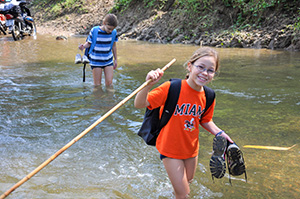River and water crossing in hiking
Crossing rivers or lakes can be risky. Waters that seem still could have strong currents and shallow waters could suddenly turn out to be quite deep. Assessing the situation is step one. Knowing how to deal with possible water dangers is step two. In this section we will give some guidelines on crossing rivers and lakes and how to deal with Water Hazards.
If you can avoid river wading and especially swimming then do so! If there is a bridge 1 mile along the river then detour and take the bridge. Safety always comes first!
In general you should try to remain calm when anything happens to you and you end up in the water. Frantic swimming will exert you quickly. Try to remain calm and float as you assess your situation and try to come up with a solution.
Should you be swept away when crossing a river and the river is filled with obstacles like rocks and logs then the safest position is to float on your back with your legs in front of you to absorb any bumps while using your arms to push away obstacles and steer.
If a teammate falls into the water, try using a rope or sticks to try and get him/her back to shore. Keep the rope flexible and do not tie it to a tree or other objects. A strong current might drag the victim under with no slack to submerge again.
Stream & River Wading
 |
| River crossin |
Smaller rivers often have boulders. Try finding a place where you would be able to cross the river by using these boulders as stepping stones. Extend your hiking poles so you can plant them in the water for balance. If you do not have hiking poles with you find a large stick. Go from boulder to boulder planting the ball of your feet on the summit of each boulder. Wet rocks, especially those overgrown with mosses, can be very slippery so go slow and plan your moves.
Always walk along the river bank and find a good place to cross. Do not try to find the place where the river is narrowest. Often the wider parts of the river have slower currents and shallower waters. Look for boulders that either provide a path or at least slow down the current and provide easy surfaces of deposited gravel behind them. Choose a route that offers safe passage on the way to the other site and a route that is back-trackable should things get rougher.
If you have to wade through the river then assess the river bottom surface. Only go in with bare feet if you are sure that there is no chance of cuts or serious scrapes. If you go bare feet then put your sock in your boots and put them in your backpack and use your backpack's splash cover. If your backpack is full then tie the laces together and hang them on your backpack. If you brought a pair of sandals then this would be a great time to use them.
You can assess the current of a flowing river by throwing a stick or other floating object in the water. You will be surprised how seemingly calm rivers can still have a strong current. In stronger currents plan a route that angles down and across the current of the river.
Undo the waist belt of your backpack! Should you fall your backpack could drag you down and seriously constrain your movement. With your waist belt undone you will be able to easily slip out of your backpack should you get dragged away.
Upadated : Aug. 2023
Recommended for You